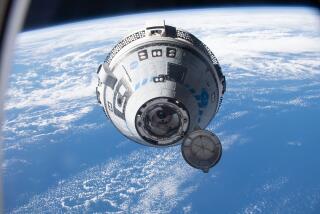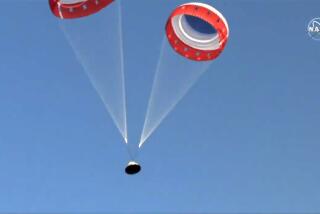Shuttle Pioneer Calls for End to Manned Flights
Max Faget, one of the nationâs most important spacecraft designers, says the space shuttle -- which he helped pioneer -- should be retired and the human space program suspended until the nation can build a better vehicle for putting astronauts into orbit.
Similar calls for grounding the shuttles and other harsh assessments of its safety have been growing over the last week from members of Congress and space policy experts who say the fleet is too unreliable, too old and too costly to continue operating.
But such views have largely represented critics outside the circle of elite space engineers. Faget designed the Mercury space capsule and had a managing role in the design of every other U.S. human launch system, including the space shuttle, Apollo and Gemini.
He has received almost every commendation that exists for engineers and was inducted into the Ohio-based National Inventorâs Hall of Fame earlier this year.
âThe bottom line is that the shuttle is too old,â Faget, 81, said in a telephone interview Wednesday from his home near Houston. âIt would be very difficult to make sure it is in good shape. We ought to just stop going into space until we get a good vehicle. If we arenât willing to spend the money to do that, then we should be ashamed of ourselves.â
The aerospace industry is already positioning itself for such an effort, industry sources say. Boeing Co. is studying two options for building a derivative of the shuttle that could be rushed into service within three years. Until then or until the shuttle flies, NASA is relying on the Russian Soyuz capsule to get back and forth to the International Space Station.
Faget (pronounced fah-ZHAY), director of engineering for human spacecraft design at NASA for 20 years, was blunt in his criticism of the growing U.S. reliance on the Soyuz. The craft ran into problems earlier this month when a three-man crew returning from the space station landed hundreds of miles off course.
âIt is like going down the highway and thumbing a ride,â he said. âYou can do it, but it isnât the best way to get around. It is really admitting defeat.â
NASA officials did not respond directly to Fagetâs comments, though they said the âshuttle he designed 30 years ago is not the shuttle of today,â noting it has been upgraded and modernized. However, NASA engineers at the working level said privately that they regard Faget as âa giant in the space community whose opinions are worth more than anybody elseâs.â
Roger Launius, chairman of the history division at the Smithsonian Air and Space Museum, called Fagetâs role in U.S. space development âvery significant,â noting it was his influence at the Johnson Space Center that led to the whole concept of a winged, reusable spacecraft during the late 1960s when the shuttle program originated.
âHe has had his finger on the design of every U.S. space vehicle,â Launius said. âHis opinion matters. People have a lot of respect for him. I would suspect there are a lot of people who agree with him.â
The shuttle was harshly criticized last week during a congressional hearing, when Rep. Joe Barton (R-Texas) called for its permanent grounding. Rep. Dana Rohrabacher (R-Huntington Beach), chairman of the subcommittee on space and aeronautics, said the vehicle is now so old that the country should no longer invest money in improving it.
Whether the technology of the existing fleet should be updated or a new fleet of spacecraft built is the subject of an intensifying national debate about the future of the U.S. human space program. At issue is how many billions of additional dollars the nation can afford for the program.
In Fagetâs view, the choices are obvious.
âWe ought to get a decent vehicle,â he said. âIt could carry fewer people, but it ought to be a new vehicle.â
The current shuttles can carry seven astronauts, the most any spacecraft has ever transported and its 60-foot long payload bay remains the most capable heavy space truck in existence. For that reason, NASA said it needs the space shuttle to complete the space station.
Pending the findings of the Columbia Accident Investigation Board review, âNASA feels that the shuttle is still the most advanced, high-tech, heavy-lift vehicle in the world,â said Robert âDocâ Mirelson, a NASA spokesman. âRight now, the administration has set the priority of returning the shuttle to flight pending the findings. The shuttle is grounded and will stay grounded until we are absolutely certain it can return to flight safely.â
A number of past efforts by the agency to replace the shuttle have failed for technical, political or monetary reasons. Boeing has begun new efforts on its own to examine how quickly it could turn out a replacement spacecraft.
Mike Lounge, a former astronaut who is now manager for Boeingâs NASA Systems in Houston, told attendees at the 40th Space Congress in Cape Canaveral, Fla., last week that Boeing engineers were doing an âinternal exerciseâ to determine the best way to construct a replacement shuttle if one were needed.
Two options are under study, according to a source familiar with the effort. One would use old blueprints but adopt modern manufacturing techniques. The other would build a modernized shuttle using the same âmold lineâ or shape of the current fleet but with the latest lightweight composite materials and advanced electronic equipment.
In either scenario, the shuttle would also incorporate any new equipment that the Columbia investigation panel might recommend. The source said Boeing believes it can build such a shuttle in three years, far less than the decade or so it would take to develop and build the orbital space plane that NASA envisions as the replacement for the shuttle. The new vehicle would also cost significantly less, according to Boeingâs internal projections, at about $2 billion, compared to about $10 billion for the orbital space plane.
Faget said such a program might make sense, but questioned why anybody would use the same shuttle architecture that he pioneered almost 30 years ago.
More to Read
Sign up for Essential California
The most important California stories and recommendations in your inbox every morning.
You may occasionally receive promotional content from the Los Angeles Times.











